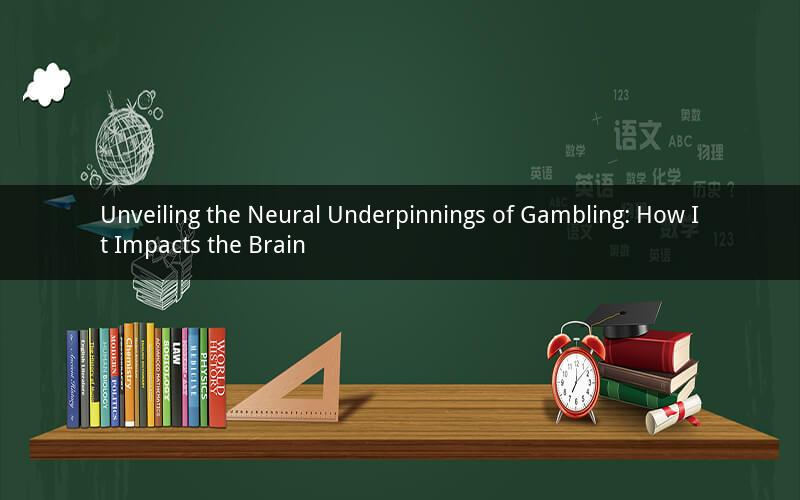
Gambling, an ancient form of entertainment, has evolved into a multi-billion-dollar industry. Despite its popularity, the consequences of gambling on the brain remain a subject of significant interest. This article delves into the intricate relationship between gambling and the brain, exploring how it affects neural circuits and cognitive functions. By understanding the neural underpinnings of gambling, we can better comprehend its addictive nature and the potential risks associated with it.
1. What are the neural circuits affected by gambling?
Gambling primarily influences the reward system in the brain. This system is composed of several key structures, including the ventral tegmental area (VTA), nucleus accumbens (NAc), and prefrontal cortex (PFC). The VTA is responsible for releasing dopamine, a neurotransmitter associated with pleasure and reward. The NAc receives dopamine signals from the VTA and plays a crucial role in mediating the rewarding effects of gambling. The PFC, on the other hand, is involved in decision-making and impulse control.
When individuals engage in gambling, the brain releases dopamine, leading to feelings of pleasure and satisfaction. This reinforces the behavior, making it more likely for individuals to continue gambling. Over time, repeated exposure to gambling can lead to the strengthening of these neural circuits, making it increasingly difficult for individuals to resist the urge to gamble.
2. How does gambling affect cognitive functions?
Gambling can have a profound impact on various cognitive functions, including decision-making, attention, and working memory. The prefrontal cortex, which plays a crucial role in these functions, is particularly affected by gambling.
Research has shown that individuals with gambling disorders often exhibit impairments in decision-making and impulse control. This is due to the fact that gambling activates the reward system, which can override the PFC's ability to regulate impulsive behaviors. Moreover, gambling can lead to attentional deficits, as individuals become preoccupied with thoughts of gambling and the potential for winning.
3. What are the long-term effects of gambling on the brain?
Long-term gambling can lead to lasting changes in the brain's structure and function. Studies have demonstrated that individuals with gambling disorders often exhibit increased gray matter density in the VTA and NAc, suggesting that these areas are more active in individuals with gambling problems.
Furthermore, long-term gambling can lead to atrophy in the prefrontal cortex, which can contribute to cognitive impairments. This includes difficulties in attention, memory, and decision-making. In severe cases, long-term gambling can even lead to the development of neurodegenerative diseases, such as dementia.
4. How does the brain adapt to gambling?
The brain has a remarkable ability to adapt to new experiences and environments. When individuals engage in gambling, the brain undergoes changes to accommodate the new activity. This includes the strengthening of neural circuits associated with the reward system and the weakening of those involved in impulse control.
As individuals continue to gamble, their brain becomes more sensitive to the potential rewards of gambling, making it even harder for them to resist the urge to continue. This adaptation is believed to be one of the reasons why gambling can become so addictive.
5. What can be done to mitigate the negative effects of gambling on the brain?
To mitigate the negative effects of gambling on the brain, it is essential to address the underlying issues that contribute to gambling addiction. This can include therapy, medication, and lifestyle changes.
Therapy, such as cognitive-behavioral therapy (CBT), can help individuals develop healthier coping mechanisms and strategies for dealing with cravings. Medications, such as selective serotonin reuptake inhibitors (SSRIs), can also be used to reduce cravings and improve impulse control.
In addition to therapy and medication, lifestyle changes can also play a significant role in mitigating the negative effects of gambling. This includes limiting exposure to gambling, engaging in healthy activities, and seeking support from friends and family.
In conclusion, gambling has a profound impact on the brain, influencing neural circuits and cognitive functions. Understanding the neural underpinnings of gambling can help us better comprehend its addictive nature and the potential risks associated with it. By addressing the underlying issues and adopting effective strategies, we can mitigate the negative effects of gambling on the brain and promote overall well-being.
Questions:
1. How does gambling affect the dopaminergic pathways in the brain?
Answer: Gambling activates the dopaminergic pathways, leading to the release of dopamine, which is associated with pleasure and reward. This reinforces the behavior, making it more likely for individuals to continue gambling.
2. Can gambling lead to cognitive impairments, and if so, how?
Answer: Yes, gambling can lead to cognitive impairments, primarily due to the atrophy of the prefrontal cortex. This can result in difficulties with attention, memory, and decision-making.
3. What role does the nucleus accumbens play in the addictive nature of gambling?
Answer: The nucleus accumbens plays a crucial role in the addictive nature of gambling by receiving dopamine signals from the ventral tegmental area and mediating the rewarding effects of gambling.
4. How can therapy help individuals overcome gambling addiction?
Answer: Therapy, such as cognitive-behavioral therapy (CBT), can help individuals develop healthier coping mechanisms and strategies for dealing with cravings, ultimately aiding them in overcoming gambling addiction.
5. Are there any genetic factors that contribute to the risk of developing a gambling disorder?
Answer: Yes, there are genetic factors that contribute to the risk of developing a gambling disorder. Research has shown that certain genetic markers may predispose individuals to gambling addiction.